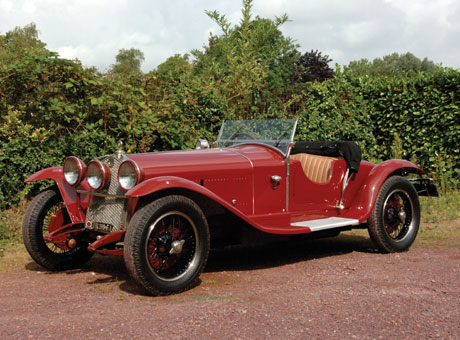SCM Analysis
Detailing
| Vehicle: | 1929 Alfa Romeo 6C 1750 Gran Sport |
| Number Produced: | 372 |
| Original List Price: | $3,692 |
| Tune Up Cost: | $900 |
| Distributor Caps: | $750 |
| Chassis Number Location: | Right frame rail behind rear axle |
| Engine Number Location: | Right side of block |
| Club Info: | Alfa Romeo Owners Club PO Box 12340 Kansas City, MO 64116 |
| Website: | http://www.aroc-usa.org |
| Investment Grade: | A |
This 1929 Alfa Romeo 6C 1750 Gran Sport sold for $865,208, including buyer’s premium, at RM’s Automobiles of London Auction in England on October 28, 2009.
The collector car world, like Hollywood, has its bona fide stars, celebrities, has-beens, and former reality show players. The ranks of has-beens are full of former celebrities who proved they weren’t on their way to being stars after all, and the brilliant light of the reality show player shines briefly indeed.
It’s not hard to place collector cars into the various categories. Try it with your friends over a few of your favorite adult beverages; it’s bound to be entertaining. That said, in the interest of keeping the SCM inbox free of burning email, I will abstain from doing so here.
The fact is, however, that if a car has the stuff, it always shows in the end. There’s no doubt the Alfa Romeo 6C 1750 is one of the top-ranked cars of all time. It has a reputation hard-won in competition and it certainly made Ugo Zagato a famous man. When many visualize a pre-war Alfa, it’s probably a Zagato-bodied 6C 1750 in their mind’s eye. No wonder-it’s one of those cars that just looks right, a perfect blend of smooth and aggressive.
Of course, when new you bought a 6C 1750 chassis with drivetrain and clothed it in whatever coachwork you wanted; until recently, not many enthusiasts cared for the more mundane cabriolets, coupes, and sedans. Many became Zagato replicas and more’s the pity.
Delightful for the clothes it wears
This car is delightful in that it retains its original body rather than a sexier replica Zagato body, even if it serves to demonstrate the true beauty of the more desirable design. It is also a testament to the aggressive use to which it was put when new to learn that it needed a repaint and interior re-trim when only eight years old.
To my mind, it’s unfortunate that Ralph Stein felt compelled even then to switch the color from the original gray to red, but I suppose nothing really changes when it comes to the perception of Italian high-performance cars. Somehow red is their natural color, no matter in what hue they left the factory. Even if the closest you get to competition is the parking lot at the racetrack, it’s got to look the part.
To be fair, of course, this car’s top-line spec does entitle it to wear red paint if it chooses. It is, after all, the same short-wheelbase, supercharged-engine chassis which powered the 6C 1750 to impressive results in race after race in 1929, ’30, and ’31. Research has determined that this car didn’t begin life with a blower; however, it was a common fitting to the short-wheelbase Gran Turismo chassis, and apparently this car has had the supercharger for quite a long time.
Some observers in the U.K. felt the car was a bit over-restored, but that’s very much a personal perception. It certainly appeared in photographs to be finished to a very high level, and the care taken and expense incurred in doing this work on a non-Zagato-bodied car is to be commended.
Many who are active in pre-war Alfa circles were astonished by the strong result this 6C 1750 achieved. After failing to meet reserve on the block, a post-sale deal was concluded at $865,209 on its estimate of $800k-$900k. To place the sale in perspective, in the confident August 2008 market, Gooding & Company achieved $1.3m for a superbly restored Zagato 6C 1750, and Bonhams & Butterfields got $1.1m for an example with Scuderia Ferrari history and a nice patina.
Don’t forget the Hollywood factor
More recently there was confirmed private sale of $500k for another Zagato with a good period competition record and an original body in need of about $100k in work to complete it. In this light, this non-Zagato street car by a little-known body maker can certainly be considered well sold indeed.
However, it’s important to consider another dynamic-the Hollywood factor. With the softening in most prices has also appeared a curious strength in certain pockets, and that’s where the Hollywood factor comes in. In any market, especially a soft, buyer’s market, the smartest money realizes that what may seem a bargain today since it’s fallen so far will likely be the last thing to appreciate in an upturn-if it does at all.
So buying the best you can when it comes available is in the long term the genius play. Since 6C 1750s have always been at or near the top of collectors’ lists practically since they were new, it shouldn’t surprise that heritage, provenance, and condition trumped conventional wisdom. Well sold, therefore, but also a smart buy.
